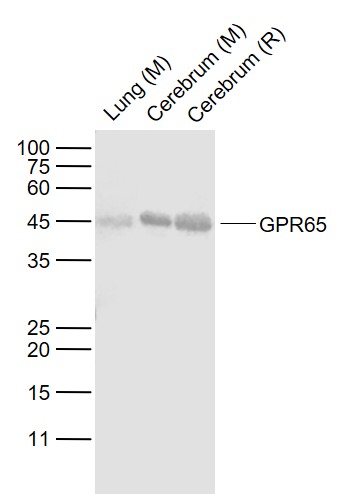GPR65 Rabbit pAb
GPR65 Rabbit pAb
- 产品详情
- 实验流程
- 背景知识
Application
| WB |
|---|---|
| Primary Accession | Q8IYL9 |
| Reactivity | Human, Mouse, Rat |
| Host | Rabbit |
| Clonality | Polyclonal |
| Calculated MW | 39333 Da |
| Physical State | Liquid |
| Immunogen | KLH conjugated synthetic peptide derived from human GPR65 |
| Epitope Specificity | 51-120/337 |
| Purity | affinity purified by Protein A |
| Buffer | 0.01M TBS (pH7.4) with 1% BSA, 0.02% Proclin300 and 50% Glycerol. |
| SUBCELLULAR LOCATION | Cell membrane. |
| SIMILARITY | Belongs to the G-protein coupled receptor 1 family. |
| Important Note | This product as supplied is intended for research use only, not for use in human, therapeutic or diagnostic applications. |
| Background Descriptions | GPR65 is a member of the G protein coupled receptor family. It has been reported in human in peripheral blood leukocytes, spleen, lymph node, and thymus. The ligand for this protein is psychosine. GPR65 may have a role in activation-induced cell death or differentiation of T cells. |
| Gene ID | 8477 |
|---|---|
| Other Names | G-protein coupled receptor 65, Psychosine receptor, T-cell death-associated gene 8 protein, GPR65 {ECO:0000303|PubMed:27287411, ECO:0000312|HGNC:HGNC:4517} |
| Target/Specificity | Predominantly expressed in thymus, spleen, lymph nodes, small intestine, lung, placenta and peripheral blood leukocytes. |
| Dilution | WB=1:500-2000 |
| Storage | Store at -20 °C for one year. Avoid repeated freeze/thaw cycles. When reconstituted in sterile pH 7.4 0.01M PBS or diluent of antibody the antibody is stable for at least two weeks at 2-4 °C. |
| Name | GPR65 {ECO:0000303|PubMed:27287411, ECO:0000312|HGNC:HGNC:4517} |
|---|---|
| Function | Proton-sensing G-protein coupled receptor activated by extracellular pH, which is required to monitor pH changes and generate adaptive reactions (PubMed:15326175, PubMed:15618224, PubMed:20855608, PubMed:33478938, PubMed:37722051, PubMed:39753132). Activated by an optimal pH of 7.4 (PubMed:39753132). Ligand binding causes a conformation change that triggers signaling via guanine nucleotide- binding proteins (G proteins) and modulates the activity of downstream effectors, such as adenylate cyclase (PubMed:15326175, PubMed:15618224, PubMed:37722051, PubMed:39753132). GPR65 is mainly coupled to G(s) G proteins and mediates activation of adenylate cyclase activity (PubMed:15618224, PubMed:37722051, PubMed:39753132). May also act as a receptor for the glycosphingolipid psychosine (PSY) and several related glycosphingolipids (PubMed:11309421, PubMed:15326175). Plays a role in immune response by maintaining lysosome function and regulating T-cell metabolism (PubMed:27287411). Acts as a regulator of inflammation by mediating pH-sensing of extracellular acidification which takes place in inflamed tissues: activation regulates endo-lysosomal function of immune cells and T-cell metabolism (By similarity). Constitutively active in endosomes and stimulates adenylate cyclase production from endosomes independently from extracellular pH changes (PubMed:39753132). |
| Cellular Location | Cell membrane; Multi-pass membrane protein. Early endosome membrane; Multi-pass membrane protein. Late endosome membrane; Multi-pass membrane protein. Note=Internalizes and localizes to early and late endosomes, from where GPR65 signals at steady state, irrespective of extracellular pH (PubMed:39753132). Changes in extracellular pH may relocalize receptor signaling to the cell membrane (PubMed:39753132). |
| Tissue Location | Predominantly expressed in thymus, spleen, lymph nodes, small intestine, lung, placenta and peripheral blood leukocytes |
Research Areas
For Research Use Only. Not For Use In Diagnostic Procedures.
Application Protocols
Provided below are standard protocols that you may find useful for product applications.
BACKGROUND
GPR65 is a member of the G protein coupled receptor family. It has been reported in human in peripheral blood leukocytes, spleen, lymph node, and thymus. The ligand for this protein is psychosine. GPR65 may have a role in activation-induced cell death or differentiation of T cells.
终于等到您。ABCEPTA(百远生物)抗体产品。
点击下方“我要评价 ”按钮提交您的反馈信息,您的反馈和评价是我们最宝贵的财富之一,
我们将在1-3个工作日内处理您的反馈信息。
如有疑问,联系:0512-88856768 tech-china@abcepta.com.
¥ 1,500.00
Cat# AP58706























 癌症的基本特征包括细胞增殖、血管生成、迁移、凋亡逃避机制和细胞永生等。找到癌症发生过程中这些通路的关键标记物和对应的抗体用于检测至关重要。
癌症的基本特征包括细胞增殖、血管生成、迁移、凋亡逃避机制和细胞永生等。找到癌症发生过程中这些通路的关键标记物和对应的抗体用于检测至关重要。 为您推荐一个泛素化位点预测神器——泛素化分析工具,可以为您的蛋白的泛素化位点作出预测和评分。
为您推荐一个泛素化位点预测神器——泛素化分析工具,可以为您的蛋白的泛素化位点作出预测和评分。 细胞自噬受体图形绘图工具为你的蛋白的细胞受体结合位点作出预测和评分,识别结合到自噬通路中的蛋白是非常重要的,便于让我们理解自噬在正常生理、病理过程中的作用,如发育、细胞分化、神经退化性疾病、压力条件下、感染和癌症。
细胞自噬受体图形绘图工具为你的蛋白的细胞受体结合位点作出预测和评分,识别结合到自噬通路中的蛋白是非常重要的,便于让我们理解自噬在正常生理、病理过程中的作用,如发育、细胞分化、神经退化性疾病、压力条件下、感染和癌症。






